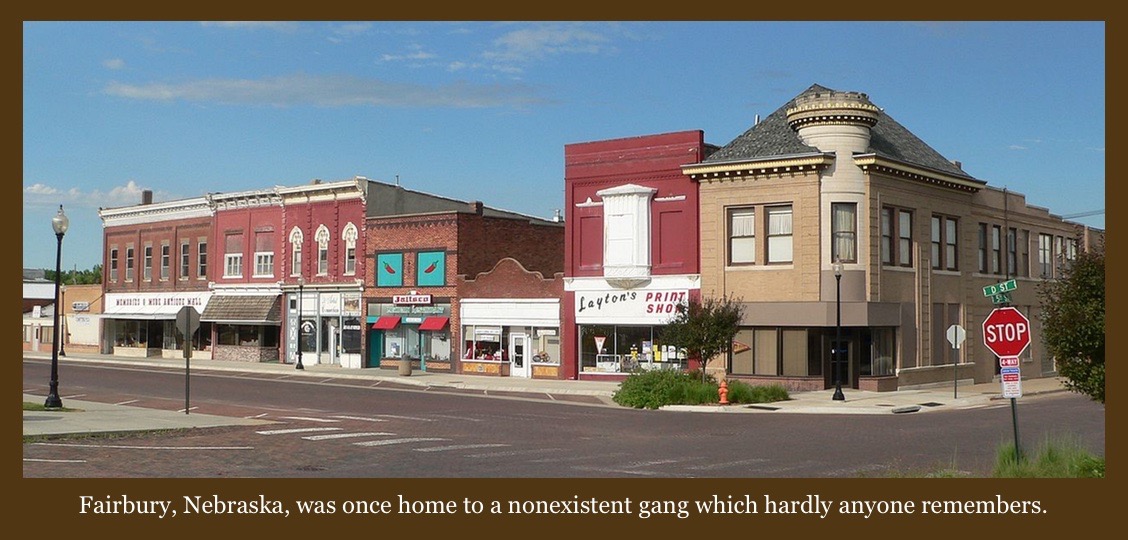Having no compelling reason for traveling to Fairbury, Nebraska, we never went there. My mother and my aunts dearly loved to haunt the grocery stores and five-and-dimes in surrounding towns that were larger than ours, and almost every town around us was larger. Our town dwarfed only Lovewell and Montrose, both unincorporated villages, though even Montrose had a thriving filling station and cafe that served local farmers and hungry travelers on Highway 36.
My family made weekly shopping trips to Beloit or Concordia or Superior, each one only about 30 miles from our driveway. Once every month or two, the lure of Grand Island or Salina got the better of us. These were big towns nearly a hundred miles away, but towns that held the promise of an Alco or Gibsons discount center and vast supermarket shelves brimming with loss-leaders. Fairbury was over 60 miles distant and boasted a population of only about 5,500 citizens. Judging from the photo posted on Wikipedia, it seems to be a well-preserved Victorian-era town, although to us in 1959 it was only one of the city names reeled off on Bob Taylor’s weather report on KOLN-TV, that is, until we began to learn about the legendary exploits of the Fairbury Gang.
Having heard nothing about the gang since then, I googled them last week and was surprised to get a hit. Ironically, what turned up from a search for the term “Fairbury Gang" was an item from a Lincoln newspaper published in 1959, although the bit from the Star concerned a dozen local pugilists who were taking part in a boxing tournament, not a roving band of teenage thugs and their wanton girlfriends. For several weeks that autumn, the Fairbury Gang was the talk of a small area in the middle of the country which was probably still on edge several months after Charles Starkweather’s murder spree ended in January 1958.
The twenty-year-old Starkweather and his fourteen-year-old girlfriend Caril Ann Fugate had fled from Lincoln, Nebraska, to Douglas, Wyoming, leaving a trail of eleven human bodies and a few dead pets. The slain included Caril Fugate’s mother and stepfather, and the couple’s two-year-old daughter, the youngest victim. The oldest was 70, August Meyer, a friend of the Starkweather family. Charles Starkweather shot him in the head with a shotgun and killed his dog. What may have unnerved people most was the complete lack of sense or pattern to the killings. While a few of Starkweather’s victims were acquaintances, many more were strangers whose paths crossed his. Most were shot, a few were stabbed, and another dog’s neck was snapped. The killers were ruthless, mobile, and could be headed to your town next. Captured, tried, and sentenced to death, Charles Starkweather was electrocuted in June 1959. Caril Ann Fugate, the youngest woman ever tried for first-degree murder, received a life sentence for being an accessory to the murder of 17-year-old Robert Jensen, but was paroled after serving 17 years.
Even after justice had been meted out and the chief bogeyman was dead and buried, middle America remained spooked to the core. Our region was familiar with news accounts of inner-city gang-related violence, the occasional rural bank robbery, even the odd headline-grabbing murder committed out of jealous rage. Those were crimes that happened somewhere else, and were committed for evident motives, crimes whose victims we didn’t know, and who may or may not have had it coming. But now there was a new breed of criminal in our own backyard who looked like the kid down the street who performed odd jobs or who rode down alleys clinging to the back of the garbage truck (as Starkweather had done), a polite boy who one day just snapped after years of being bullied, and became a thrill-killer who struck without provocation or mercy. It didn’t help matters that he looked like the boy any teenage girl's father would dread to see coming up the porch steps, one with longish slicked-back hair who probably revved his car at stoplights and played the car radio loud enough to signal his approach from blocks away.
With Starkweather recently laid to rest, suddenly there was this new threat, a gang of amoral teens prowling the back roads scouting for hapless prey. They were not killers, not yet anyway, satisfied for the moment to torment their victims with the sort of aimless, sadistic violence that mean little boys have been known to inflict on baby birds and grasshoppers. Yet, the most disturbing stories connected with the Fairbury gang concerned the cruelties perpetrated by its female members. Someone said the Fairbury girls had slit the eye of an innocent bystander who didn’t get out of their way quickly enough or stared at them too long. A girl in stiletto heels had stomped one keenly-sharpened heel clean through the outstretched hand of a male victim while some of the girls' boyfriends held him down. Every weekend brought a fresh batch of stories featuring some novel outrage.

The yarns probably revealed more about the people who spread them than about the youth of Fairbury, because the stories turned out to be tall tales with maybe a kernel of truth. It transpired that the celebration after a sports victory had gotten out of hand and spread to the main streets of surrounding towns. There was honking and yelling and one exuberant teen may have taken a swing at another. That was about the extent of the mayhem. Instead of the hardened gang molls we had breathlessly envisioned, plastered with mascara and balanced on stiletto heels, there had been only fresh-faced cheerleaders in saddle oxfords rooting their boys on to victory, and then maybe urging a classmate to clobber some snotty kid from another school.
That November, Richard Hickock and Perry Smith murdered four members of the Clutter family at Holcomb, Kansas, and we could again turn our attention to real threats for a while without having to make them up.